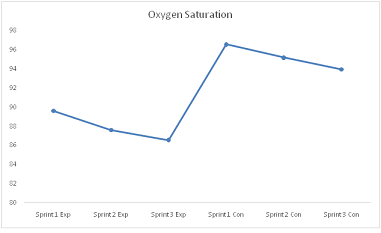ARE YOU LOOKING FOR RELIABLE PHYSIOLOGY OF SPORTS PERFORMANCE ASSIGNMENT HELP SERVICES? EXPERTSMINDS.COM IS RIGHT CHOICE AS YOUR STUDY PARTNER!
Physiology of Sports Performance Laboratory - Environmental Effects on Intermittent Sprint Exercise Report
Results -
Table 1:Participant age, height, and body mass.Values are mean ± standard deviation (SD).
|
Characteristic
|
Tested Sample
|
|
Age (years)
|
22.52 ± 3.23
|
|
Height (m)
|
1.74 ± 0.09
|
|
Body Mass (kg)
|
72.97 ± 13.5
|
Table 2: Performance and physiological responses during, and immediately following, intermittent sprint cycling in............ Values are mean ± SD.
|
Experimental Condition
|
Control Condition
|
|
Sprint 1
|
Sprint 2
|
Sprint 3
|
Sprint 1
|
Sprint 2
|
Sprint 3
|
|
Peak Power Output
|
751.02 ± 232.91
|
724.9 ± 239.67
|
659.09 ± 231.93
|
801.61 ± 267.94
|
745.79 ± 223.01
|
640.61 ± 192.47
|
|
Mean Power Output
|
550.19 ± 155.47
|
508.8 ± 147.25
|
474.88 ± 144.38
|
563.94 ± 174.65
|
524.1 ± 138.84
|
465.38 ± 123.99
|
|
Oxygen Uptake
|
1.62 ± 0.82
|
1.61 ± 0.66
|
1.68 ± 0.97
|
1.79 ± 0.68
|
1.89 ± 0.93
|
1.81 ± 0.85
|
|
Heart Rate
|
157.04 ± 23.71
|
162.62 ± 22.17
|
167.91 ± 14.67
|
154.81 ± 21.6
|
164.96 ± 16.23
|
166.64 ± 14.3
|
|
Oxygen saturation
|
89.63 ± 6.92
|
87.6 ± 6.59
|
86.55 ± 6.74
|
96.62 ± 3.54
|
95.22 ± 6.29
|
93.98 ± 6.55
|
|
Blood Lactate
|
9.45 ± 2.97
|
14.6 ± 3.53
|
17.16 ± 3.05
|
8.22 ± 3.27
|
13.88 ± 4.74
|
16.59 ± 3.81
|
|
Blood Glucose
|
5.74 ± 1
|
6.3 ± 1.74
|
6.16 ± 0.96
|
5.45 ± 0.59
|
5.76 ± 0.77
|
5.79 ± 0.78
|
SAVE YOUR HIGHER GRADE WITH ACQUIRING PHYSIOLOGY OF SPORTS PERFORMANCE ASSIGNMENT HELP & QUALITY HOMEWORK WRITING SERVICES OF EXPERTSMINDS.COM!
Q1. Did hypoxia affect intermittent sprint performance? If so, on which sprint bouts did the hypoxia have the greatest impact?
Answer - The graph given below shows the how hypoxia affect intermittent sprint performance

The mean oxygen saturation for Sprint 1 in experiment group is 89.63 ± 6.92, the mean oxygen saturation for Sprint 2 in experiment group is 87.6 ± 6.59, and the mean oxygen saturation for Sprint 3 in experiment group is 86.55 ± 6.74. On the other hand, the mean oxygen saturation for Sprint 1 in control group is 96.62 ± 3.54, the mean oxygen saturation for Sprint 2 in control group is95.22 ± 6.29 and the mean oxygen saturation for Sprint 1 in control group is93.98 ± 6.55. On comparing the mean plot, we see that the Sprint 3 in Experiment group is less in Oxygen saturation when compared to other groups. Thus, we can say that Sprint 3 in experiment group experience the greatest impact of hypoxia.
Q2. Which physiological variables measured during (or immediately post) intermittent sprint exercise were affected by hypoxic conditions?
Answer - Here, we see that the factors Heart Rate, Blood Lactate and Blood Glucose were also affected by hypoxic conditions.
Q3. How do the above findings compare to the available scientific literature on intermittent sprint exercise in hypoxic conditions? Why are the results similar or different to previous research?
Answer - According to RaphaëlFaiss (2013), the study findings initially summarizes the main mechanisms related to interval training and also focussed on the repeated sprint training in normoxia. The study findings suggested that when athletes were involved in intermittent hypoxic training (IHT), then, their performance were affected to a great extent and their popularity also goes down gradually. Thus, proper care has to be taken for the athletes who were suffering or having issues related to hypoxia
The same findings was observed in our study too, as we can say that Sprint 3 in experiment group experience the greatest impact of hypoxia.
DO YOU WANT TO EXCEL IN PHYSIOLOGY OF SPORTS PERFORMANCE ASSIGNMENT? HIRE TRUSTED TUTORS FROM EXPERTSMINDS AND ACHIEVE SUCCESS!
Q4. What possible physiological mechanism(s) could explain the difference (if any) in intermittent sprint exercise performance between hypoxic and normoxic conditions. If there was no difference in performance, what may have caused such a finding?
Answer - The performance gets lowered down for hypoxia athletes when compared to that of normoxia athletes. That is, athletes who are suffering from hypoxia, they tend to have poor benefits related to sea - level performance improvement when compared with the normoxia athletes who were involved in the same method of training. Also there will be subsequent drop in optimal training stimulus for the athletes in hypoxia when compared to that of normoxia athletes.
Q5. What are the practical applications of your findings (e.g. work to rest intervals during team sports)?
Answer - The following practical implications should be followed to overcome from this issue
1. We should implement altitude training in the intermittent sports which would certainly improve the specific fitness of athletes
2. Repeatedly performing intense exercise bouts could also benefit the athletes
3. Sports Specific training methods needs to be implemented as mandatory for athletes to reduce their stress
4. For hypoxia athletes, repeated sprint training should be performed as it will increase their self confidence levels.
ORDER NEW PHYSIOLOGY OF SPORTS PERFORMANCE ASSIGNMENT & GET 100% ORIGINAL SOLUTION AND QUALITY WRITTEN CONTENTS IN WELL FORMATS AND PROPER REFERENCING.